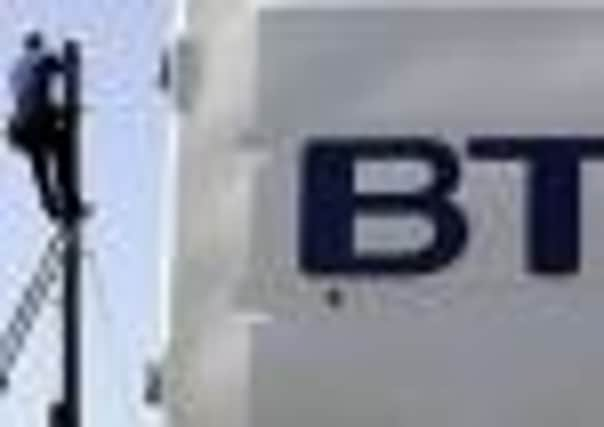Battle to run communication systems of the next century


At stake is a glittering prize – control of what is likely to be the country’s key communications network for the coming century.
With their ability to carry huge amounts of data at lightning-fast speeds, the fibre-optic cables now being laid beneath the streets of the UK look certain to one day fully replace the existing copper telephone wires upon which the country has relied for so long.
Advertisement
Hide AdAdvertisement
Hide AdBut the question over who will build this vast new network – and who will control it – has been raging in the corridors of Whitehall and the boardrooms of major technology firms for some time.
When Britain’s original telephone network was constructed, there was no such debate to be had. The publicly-owned telephone service, which eventually became British Telecom, was in charge, except in Hull.
But with BT now a privatised business, it is suddenly competing with a host of other firms as it strives to maintain its long-held monopoly over the UK’s core communications network.
Its own £2bn plan for a new fibre optic network will only cover two-thirds of the UK – the most densely-populated areas. The more remote parts, it says, are not viable without public subsidy.
Advertisement
Hide AdAdvertisement
Hide AdThe Government clearly agrees, having set up a £530m fund to support roll-out of fibre optics to the final third – but the cash will not simply be handed over to BT.
Rather, it will be given in grants to individual councils, who will then put the work out to tender.
North Yorkshire will be one of the first battlegrounds, having been chosen as a pilot area by the Government. Its £16m contract went out to tender last month.
“We will bid for every contract,” BT’s head of superfast broadband, Johnny McQuoid, told the Yorkshire Post. “But realistically we are not going to win every one.”
Advertisement
Hide AdAdvertisement
Hide AdOne key rival for BT will be Japanese firm Fujitsu. These two giants will battle it out with other global communications firms and smaller local companies for each contract.
What this means is that Britain’s future communications network is likely to be fragmented, rather than owned by a single body. But could this cause problems?
Unsurprisingly, both BT and Fujistu insist it would be better to hand them all the money rather than allow a series of networks to be constructed around the UK.
“Do we really want all these different networks all over the place?” Mr McQuoid asks.
Advertisement
Hide AdAdvertisement
Hide Ad“Potentially you’ll get them using different types of technology, and it just won’t be cost-effective for the big internet firms to have a different system for each one.
“You may find they don’t want to get on board and sell the product. That’s already happened in South Yorkshire, and it could happen in other areas too.”
In South Yorkshire, of course, it is local councils who represent the main threat to BT’s hegemony.
Fearing they would be left behind when the next generation of internet was rolled out, Sheffield, Barnsley, Rotherham and Doncaster Councils launched their ambitious plans for a publicly-owned fibre optic network in 2005.
Advertisement
Hide AdAdvertisement
Hide AdBacked by EU and Yorkshire Forward funding, council chiefs poured £10m of loans into the Digital Region scheme, expecting to receive the money back when the profits began rolling in. But with much of the network built, such a prospect looks remote.
Project managers have become bogged down in a series of bitter disputes with BT’s Openreach arm over access to the county’s existing telephone cables and cabinets. As a consequence, no big internet firms have signed up to sell the service – meaning very few customers are using it.
The resultant lack of income means plans to reach 97 per cent of premises have now become 80 per cent, with the rest postponed indefinitely.
“With any start-up business, there’s a big element of risk,” says Digital Region chief executive David Carr. “It’s inevitable. But we’ve got a business plan that works, and as long as we deliver on those plans we are fine.”
Advertisement
Hide AdAdvertisement
Hide AdComplicating matters further is the imminent arrival of BT’s own fibre network in the more populated parts of South Yorkshire.
With a large customer base and vast marketing clout, it is possible BT’s own superfast broadband service will hoover up many of the potential customers Digital Region’s business model relies on.
“It’s bound to make life more difficult,” Mr Carr admits. “But remember, BT is unlikely to offer the same penetration levels (as Digital Region), because its plan is only to cover 67 per cent of the UK.”
The key question now is whether the other public projects soon to get underway across the country – starting with North Yorkshire – will face similar issues.
“I honestly can’t see why they wouldn’t,” Mr Carr says.
Advertisement
Hide AdAdvertisement
Hide Ad“Until BT sorts out its processes and prices, the problems we have had will keep coming up. We’re just the first to get there.”
South Yorks Digital Region: Timeline
2004: Idea first floated for a publicly-owned fibre-optic network for South Yorkshire.
2005: Formal business plan approved by all four councils.
2007: Thales chosen as partner to build network.
Late 2008: Yorkshire Forward and councils give go-ahead.
November 2008: EU confirms £30m grant for project.
April 2009: Labour Government announces scheme in its Budget.
June 2009: Work begins.
December 2009: Official go live of first part of network.
May 2010: £100,000-a-year chief executive David Holt leaves post unannounced.
Advertisement
Hide AdAdvertisement
Hide AdDecember 2010: Serious disputes with BT emerge. Accounts reveal doubts over scheme’s long-term future.
July 2011: Final leg of scheme scaled back indefinitely. Ofcom offers only partial support in ongoing battle with BT.